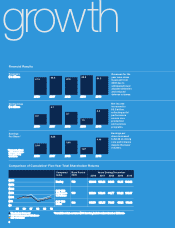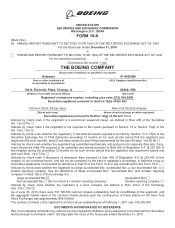Boeing 2010 Annual Report Download - page 20
Download and view the complete annual report
Please find page 20 of the 2010 Boeing annual report below. You can navigate through the pages in the report by either clicking on the pages listed below, or by using the keyword search tool below to find specific information within the annual report.that have already been produced, improving aircraft performance, successfully implementing planned
increases in production rates and introducing the 787-9 and 747-8 Intercontinental airplanes. For
example, we are increasing production capacity in Everett and Charleston and working closely with our
suppliers to support 787 production rate increases. If assembly line ramp-up efforts are delayed or if
our suppliers cannot timely deliver components to us at the rates necessary to achieve our planned
rate increases, we may be unable to meet delivery targets and the financial performance of one or
more of our programs may suffer.
Management uses its best judgment to estimate the cost to perform the work, the price we will
eventually be paid and the number of units to include in the initial accounting quantity. Changes to
estimates of the program accounting quantity, customer and model mix, production costs and rates,
learning curve, costs of derivative aircraft, customer negotiations/settlements, supplier claims and
certification issues could affect margins or result in reach-forward losses. The cumulative impact of
production challenges, schedule delays and customer and supplier impacts has resulted in a reach-
forward loss on the 747 program and continues to place significant pressure on revenues, costs and
the profitability of the 787 program.
Our BDS business could be adversely affected by changing acquisition priorities of the U.S.
government, particularly the Department of Defense, including an increased emphasis on
affordability.
The U.S. government participates in an increasingly wide variety of operations, including homeland
defense, natural disasters, stabilization efforts, counterinsurgency and counterterrorism, that employ
our products and services. The U.S. government, primarily operating through the U.S. DoD, continues
to adjust its funding priorities in response to this changing threat environment. In addition, defense
funding currently faces pressures due to the overall economic environment and competing budget
priorities. Due to these pressures, we expect the total U.S. DoD budget growth rate to remain stable or
even decline slightly over the next several years. Any reduction in the growth rate or overall levels of
U.S. DoD spending or cancellations or delays impacting existing contracts could have a significant
impact on the operating results of our BDS business. We also expect that the U.S. DoD will continue to
emphasize cost-cutting and other efficiency initiatives in its procurement processes. These initiatives
will require us and our competitors to focus increasingly on long-term cost competitiveness and
affordability when responding to proposals and/or pursuing development programs. If the priorities of
the U.S. government change and/or we are unable to meet affordability targets, our BDS revenues and
profitability could be negatively impacted.
We depend heavily on U.S. government contracts, which are subject to unique risks.
In 2010, 43% of our revenues were derived from U.S. government contracts. In addition to normal
business risks, our contracts with the U.S. government are subject to unique risks, some of which are
beyond our control.
The funding of U.S. government programs is subject to congressional appropriations. Many of the U.S.
government programs in which we participate may last several years; however, these programs are
normally funded annually. Changes in military strategy and priorities may affect our future procurement
opportunities and existing programs. Long-term government contracts and related orders are subject to
cancellation, delay or restructure, if appropriations for subsequent performance periods are not made.
The termination or reduction of funding for existing or new U.S. government programs could result in a
material adverse effect on our earnings, cash flow and financial position.
The U.S. government may modify, curtail or terminate our contracts. The U.S. government may modify,
curtail or terminate its contracts and subcontracts with us, without prior notice and at its convenience
8
























